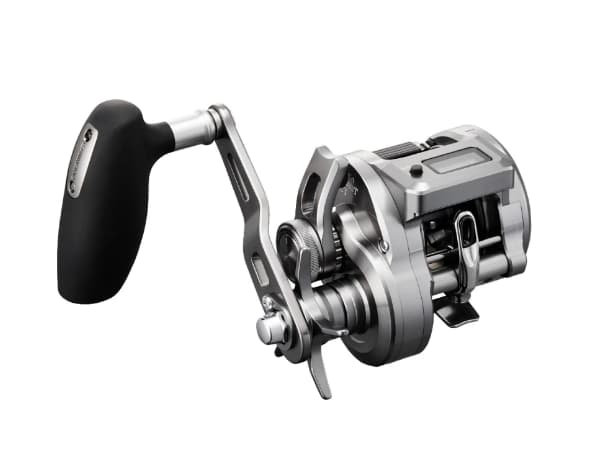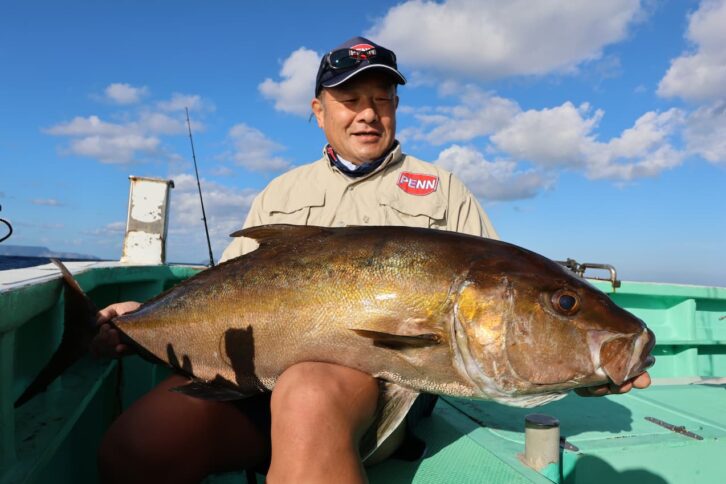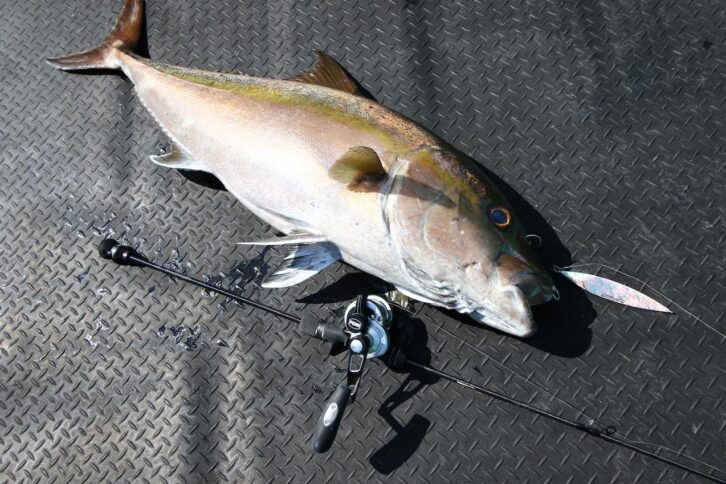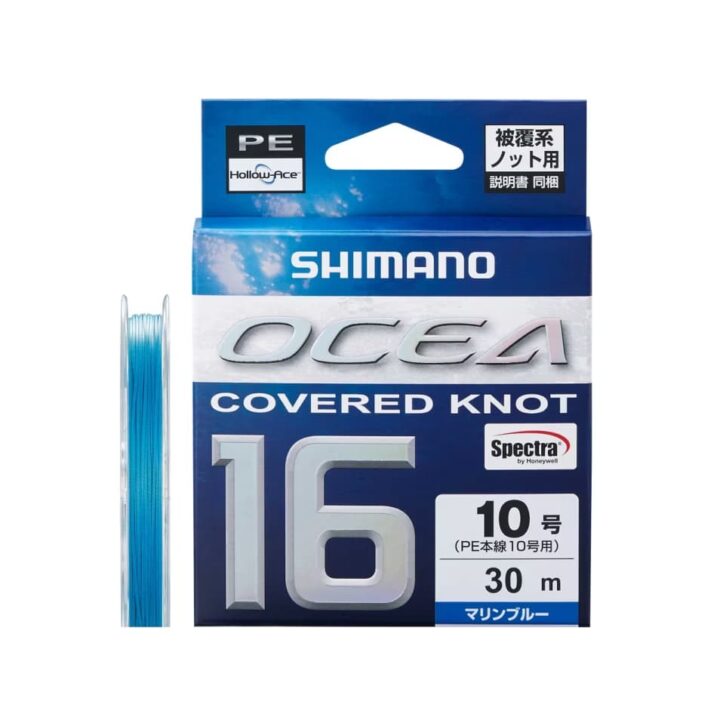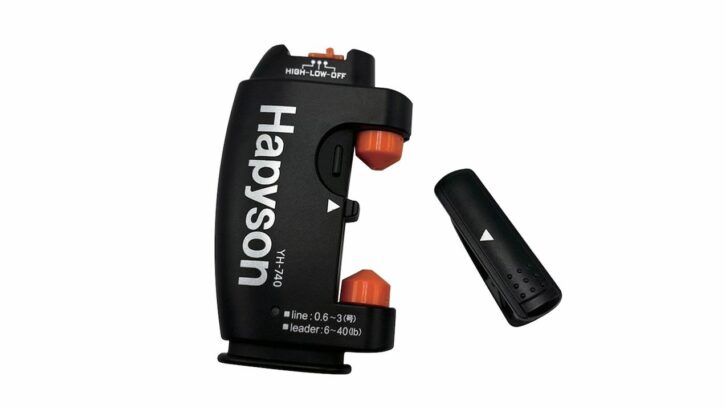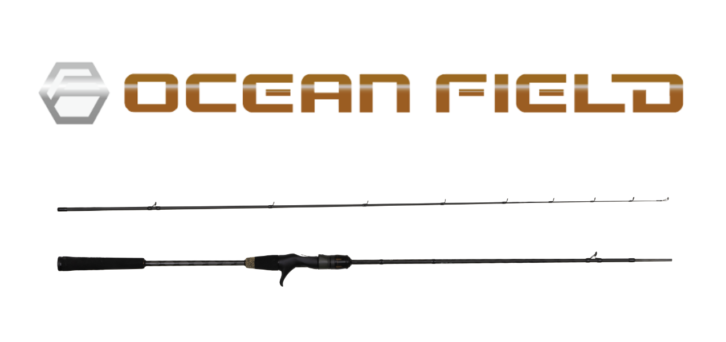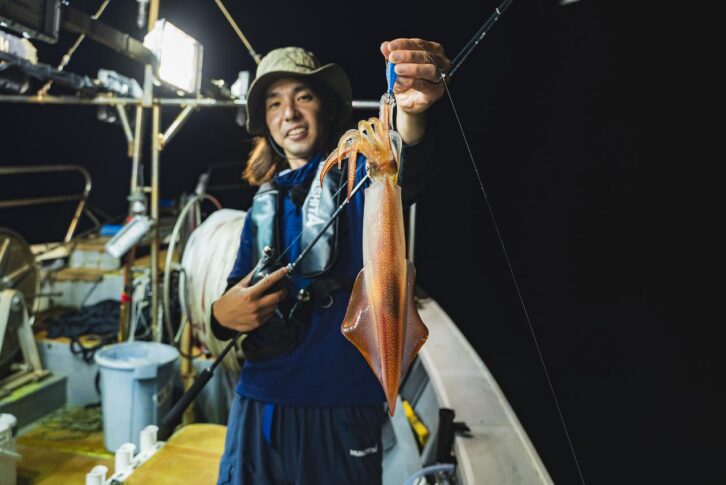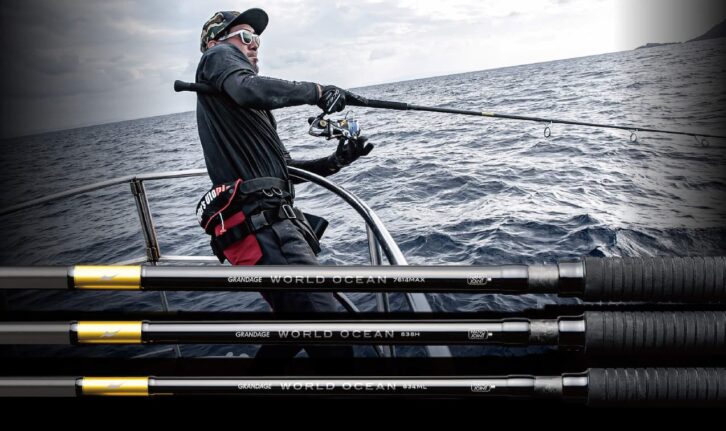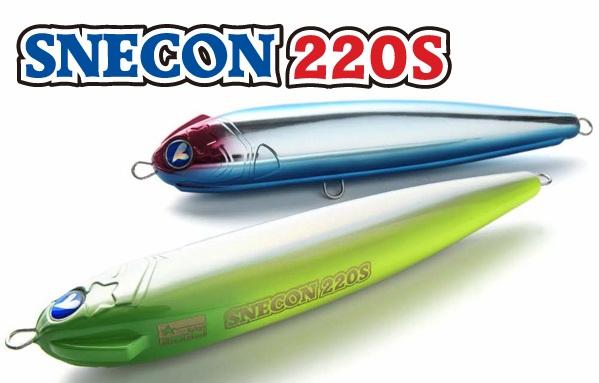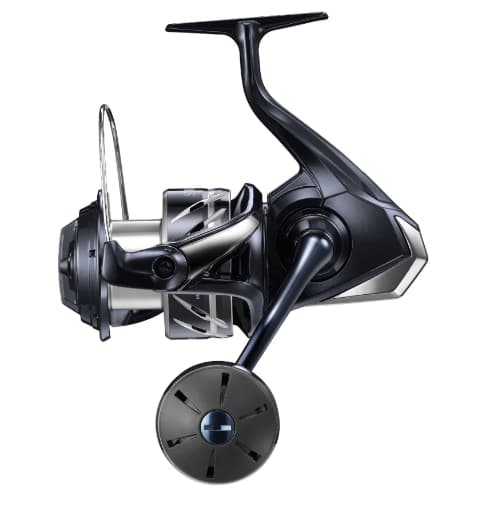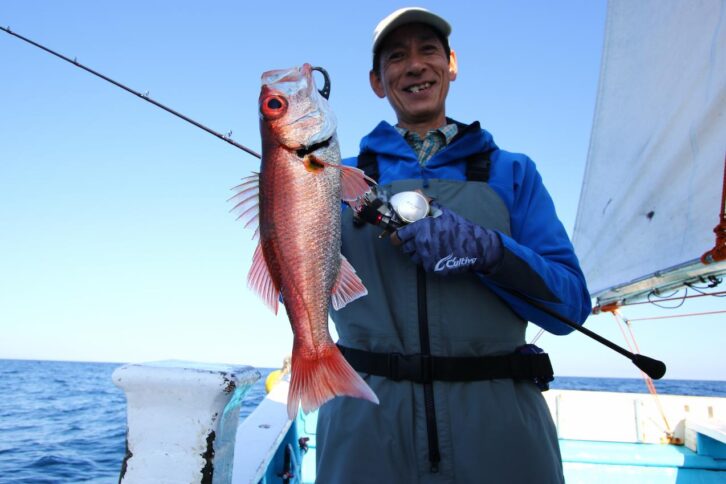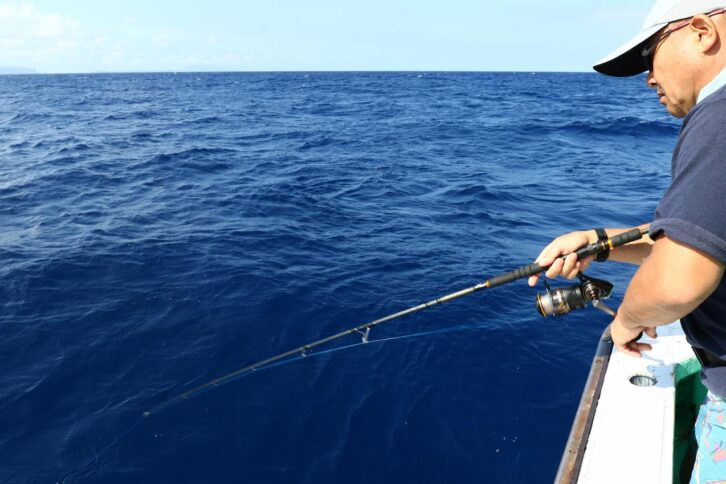Red grouper dance around the World Heritage "God's Island"!
New Discovery Rockfish Game
Okinoshima Island in Fukuoka Prefecture is called "God's Island" and is registered as a World Cultural Heritage site. Located in the Genkai Sea, Okinoshima is about an hour and a half away from the port of Kounominato in Munakata City, Fukuoka Prefecture. The points around the island are popular with anglers targeting bluefish and snapper, and many anglers visit the island throughout the year.
Haruhiko Murakami of ISSEY headed for Okinoshima. This is the first time for him to visit a point more than an hour's drive away with a target of rockfish, so let's see what kind of fishing he can do using not only his standard lures but also rods and lures that are still in the development stage.

INDEX
The first step is to set up the jig to grasp the situation.
This time, Mr. Murakami visited Okinoshima Island for the filming of Lure Paradise Kyushu TV. Mr. Murakami is widely known as an angler who enjoys fishing freely, without being bound by preconceived ideas of fishing. He also develops lures and tackle, and the products he produces from his unique perspective are the culmination of his philosophy, and many of them can open new doors to new ways of fishing if anglers think about them and use them. Each fishing trip for Mr. Murakami is like an enjoyable dialogue with the fish, and he puts into practice what he wants to try or what inspires him.
According to preliminary information, the main point of this trip was 15 to 40 meters deep, around an island in the middle of the Genkai Sea, where the current is fast and the reefs are complicated. We fished this area by dotted-lines.
The main lures Murakami prepared this time were jig heads and metal jigs. He also used a blade jig.
He used a 7-foot-8-inch bait rod and an 8-foot-3-inch spinning rod (both prototypes) from the Issey Kaitaro Heki “Isoroku” series. And two jigging rods, Issey Kaitaro Neko Shaft. In total, we prepared four rods.
The first rod Mr. Murakami picked up upon arrival at the point was a 7’8″ bait rod. It was a prototype with solid carbon blanks.
The rod is designed to be used from shore to light hard rock,” Murakami said. It has a medium-light action. Even though it’s solid carbon, it’s not “benumb-benumb,” but rather stiff overall. The tip is well connected to the subsequent sections, and when a fish is hooked, the entire rod bends beautifully.
The first lure he picked up was a 45 g Issey Kaitaro Negaitama, the heaviest of the Issey Kaitaro line, set with a #2/0 offset hook with a thick shaft, and a slightly smaller worm to make the head sink faster. The worm is Issey Kaitaro Caramel Shad 3.5 inch (Rockfish SP color). He used PE 1.5 line.
He said, “I chose a shad tail so that even a small worm would be appealing. At first, I didn’t know how well it would catch roots or how much the boat could pull with the tide, so I decided to see how it would go.
Murakami felt on his first cast that with this setting, the line seemed a little thicker due to the speed at which the boat was being swept away, the current, the depth of the water, and the resistance of the lure he was using, so he felt that when the root fish ball landed on the bottom, it did not make a sound when it landed. While thinking about this, I caught a red grouper from the first cast!
While feeling the sting of the 3.5-inch Caramel Shad he had chosen, he changed his worm to the 4.5-inch ISSEY KAITARO Katakuchi Worm in the color of akakin. The depth of the target point was 13 m. Mr. Murakami imagined that the captain would start fishing from shallower depths, where it would be easier for him to grasp the situation, and then gradually target deeper areas. He would start with shallower depths, where it would be easier for Murakami to grasp the situation. However, since the bottom of the water is shallow, the action is not only to pull the fish along the bottom, but also to bounce the fish up occasionally to show it to the surroundings to attract the fish. In this way, Mr. Murakami added good-sized red grouper to his catch.
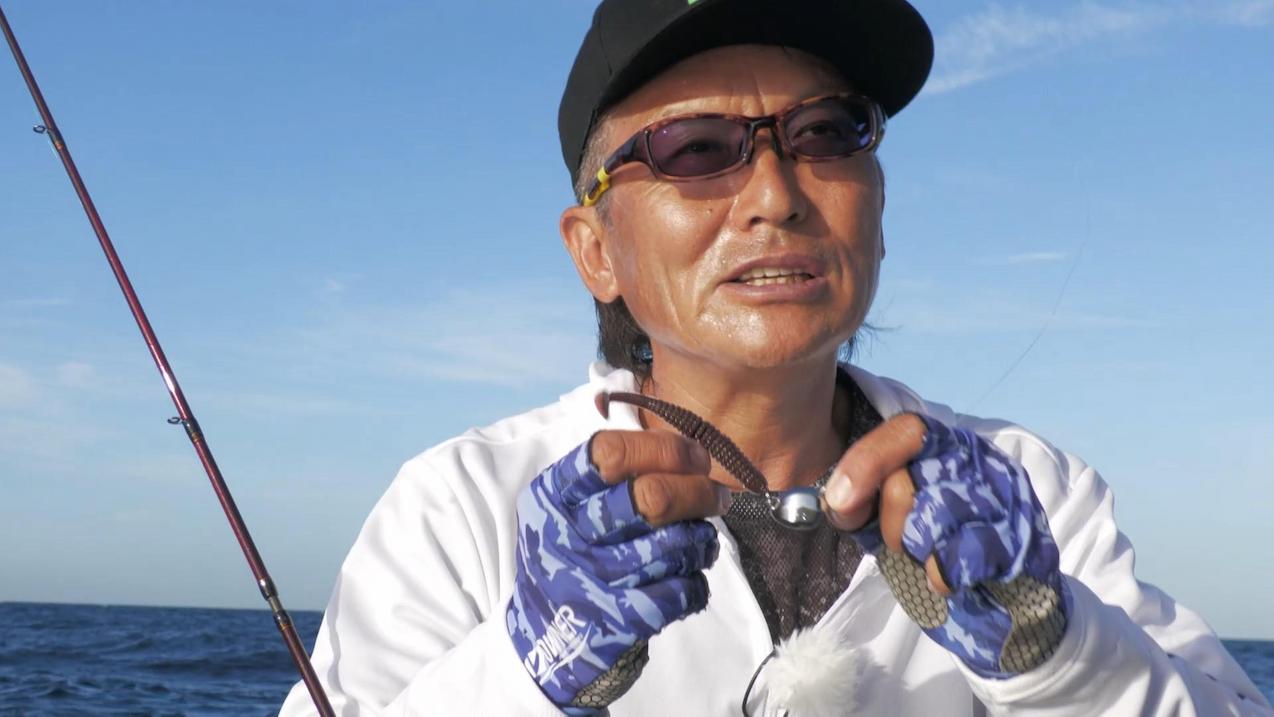
In order to grasp the situation, the first lure he used was a 45g root fish ball with a 3.5-inch caramel shad. I chose a slightly smaller worm, thinking that the head should sink quickly.
Kaitaro Negafish Ball
https://issei.tv/umitaro/523.html
Umitaro Caramel Shad
https://issei.tv/umitaro/993.html
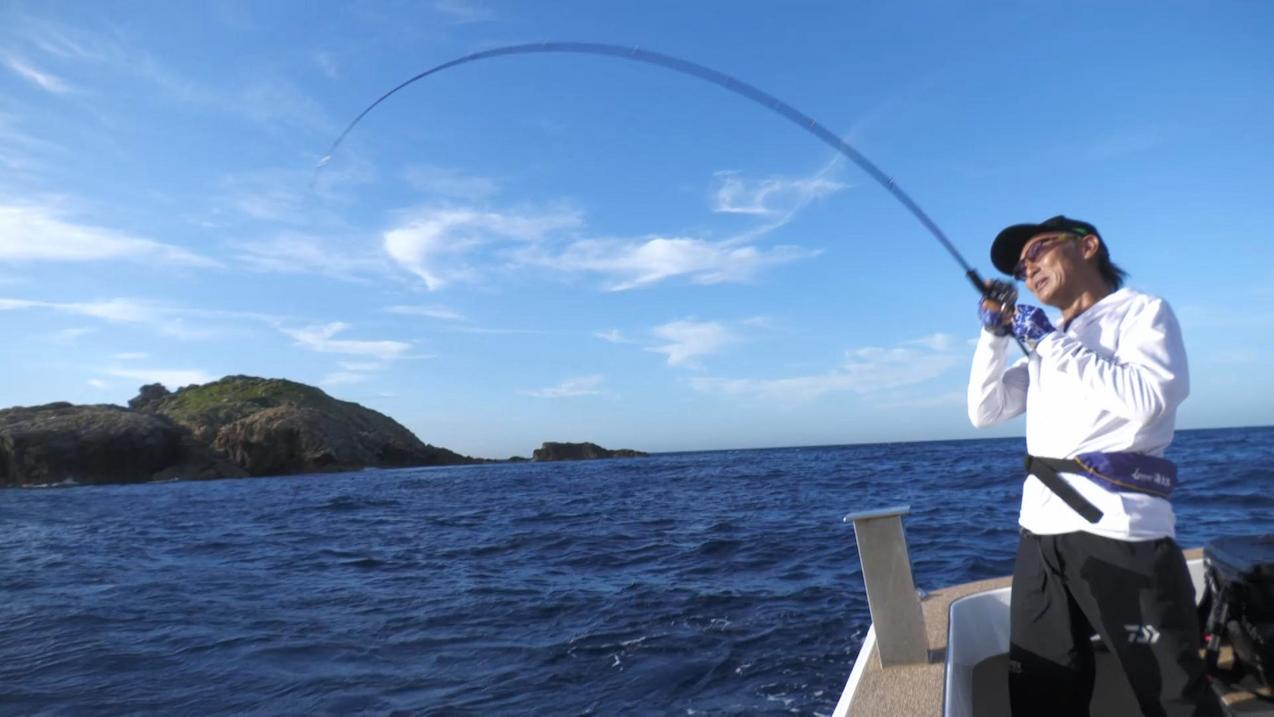
Issey Kaitaro Heki “Isoroku” series 7′ 8″ bait rod (prototype). Although it has solid carbon blanks, it is not benign and can manipulate lures firmly (the tip is not extremely soft, so the tip does not absorb rod action and as a result, the lure is less likely to get stuck in roots. (The tip is not extremely soft, so the tip does not absorb the rod action, and as a result, the lure does not easily get stuck in the roots.)

The setting to improve hooking of the 4.5-inch Katakuchi Worm is to use a horizontal hook to increase the clearance of the hook gape. The hook point has a slit in the body of the worm, so you can hide it there.
Kaitaro Katakuchi Worm
https://issei.tv/umitaro/1064.html
Fishing method changes as if from shore
Given the current conditions, it would be difficult to fish delicately by feeling the bottom with a 45g rootfish ball and a bait tackle using PE No. 1.5 in clear conditions, so to change his fishing method, Murakami next chose a prototype 8′ 3″ spinning tackle with PE No. 1. The main feature of this rod is that it can be used in the same way as the first bait, and its length makes it easy to use when dropping the lure between stones with long strokes.
Unlike the first rod, I chose a small #2 hook (Mr. Murakami calls this an unbalanced balance) and set it with an ISSEY KAITARO JacoBug 3.2 inch (Keimula Rainbow color). At first he used a lighter rootfish ball than the 45g, but eventually he used the 45g, which gave him a better sense of landing fish, and caught a series of red grouper!
He said, “No way, I prefer a small worm. Also the setting with a small hook. I like the color kei-mura, especially in Kyushu. I think it works well in blue water,” said Murakami.
Under the circumstances, it seemed as if a satisfactory result had been achieved. Murakami’s style is not to stick to one type of fishing, but to enjoy different types of fishing. Enjoying different ways of playing with fish when he can is typical of Murakami, who likes to interact with fish as well as the act of fishing.
Kaitaro Jacob’s Bug
https://issei.tv/umitaro/956.html

For anglers who cut their hands holding a bass, Murakami gives a lecture on how to hold a root fish with sharp teeth. By placing your fingers under the mouth and on the triangular part next to the mouth, you can hold the fish without damaging your fingers.
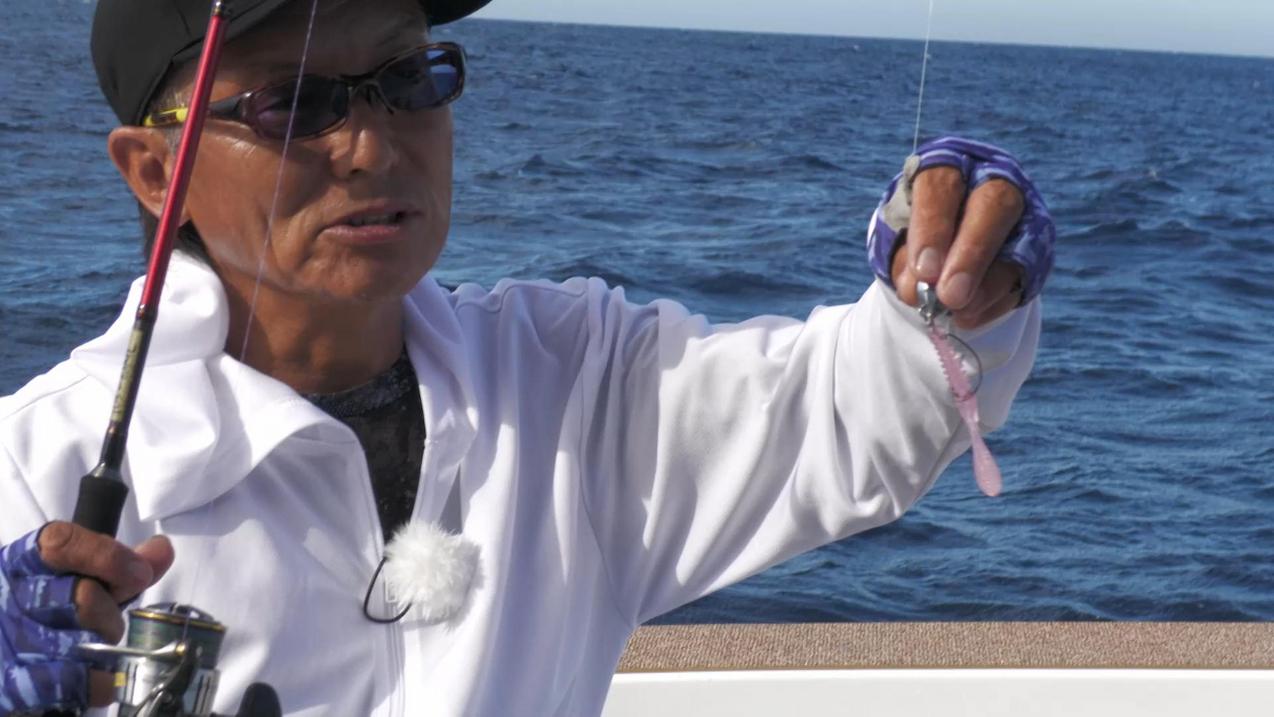
Mr. Murakami sometimes chooses to use a hook that seems small for the size of the worm, to increase the worm’s range of motion and improve its action, which he calls “unbalanced balance.
Jig setting is a trial-and-error process
Mr. Murakami changed his fishing style completely and picked up an ISSEY rod, the KAITARO Neko Shaft IU x BT-C672-3 (the final prototype he used is now on sale). The jig was Issey Kaitaro Neko Metal 100g (Iwashi Glow color). Line is PE 1.2.
The jig was set to a bottom-heavy setting, with only the upper burr set. This way, even if I shook the jig too hard, it was less likely to become a shrimp, and I could control the jig finely, such as stopping it when it was raised.
We also paid attention to where the jig landed on the water.
When you are fishing in the Doterra channel, the line will be taut even if you are trying to lure the jig in a fluffy way, so I throw the jig under the tide so that it falls directly under the water. By doing this, I can fish vertically, and when I loosen the line, the line loosens properly and I can control the jig finely, so I keep this in mind. I put the action on the bottom about three to five times, then pick it up as the line gradually becomes fouled.”
However, there were cases where he was able to get bites but was unable to hook them. Murakami hypothesizes that the reason for this may be a problem with the way the hook is set. Mr. Murakami hypothesizes that the reason for this may be a problem with the way the hook is set.
When you put the jig on the bottom, the fish that are biting only put the jig in their mouths and do not seem to be able to reach the hook. I want to hook fish that use their mouths in that way. Also, I want to attract bites when the jig is suspended. That’s why I decided to use a single hook with a tail hook to hook fish on the bottom while keeping the bottom-heavy setting,” Murakami said.
(Mr. Murakami) “If you use multiple tail hooks, it is difficult to avoid getting a root hook when the jig is on the bottom, but with a single hook, you can use the weight of the jig and shake the jig to dislodge the root hook.
Kaitaro Neko Metal
https://issei.tv/umitaro/57251.html
Murakami’s approach to jigging this time was to first let the jig rest on the bottom a little to get the fish to bite, and if no bites occurred, he would float the jig 65 cm from the bottom (one turn of the reel handle) and let it stay there to get the fish to bite. This is how he caught a good-sized red grouper!
After getting a series of good catches with this method, Murakami tried using the jigging tackle and a short 80g (tentative name, prototype) caro worm with the Surusuru Root Fish Ball, and got a series of catches there as well. After that, we continued to fish with jigs as well, depending on the conditions, and then stopped fishing.
On this fishing trip, Murakami enjoyed fishing in a hard rock area where the tide was running fast and fishing in deep water, something he had almost never done before. He enjoyed talking with the fish and adjusting his fishing style, but he also felt that he could have enjoyed fishing even more if he had used tackle and lures that he did not bring this time. In fact, this “bewilderment” is the driving force for Murakami to continue fishing tomorrow, and the reason why he continues to fish. We look forward to the next installment of Murakami’s world.

This time, Murakami fished with an eye to getting bites by keeping the jig floating about 65 cm from the bottom and holding it there. If you get a bite while the jig is floating and staying in place, the fish will automatically hook on,” he explains.

Using the Slusl Root Fish Ball (tentative name, prototype), we also caught a red grouper. In conclusion, this time, the best response from the fish was with worms. Needless to say, Mr. Murakami is thinking of a new secret plan for the next time he tries it!
Click here for information on the Lure Paradise Kyushu TV program!
https://web.tsuribito.co.jp/




